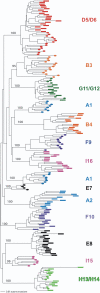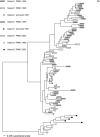HIV-1 superinfection in the antiretroviral therapy era: are seroconcordant sexual partners at risk?
- PMID: 19479055
- PMCID: PMC2684644
- DOI: 10.1371/journal.pone.0005690
HIV-1 superinfection in the antiretroviral therapy era: are seroconcordant sexual partners at risk?
Abstract
Background: Acquisition of more than one strain of human immunodeficiency virus type 1 (HIV-1) has been reported to occur both during and after primary infection, but the risks and repercussions of dual and superinfection are incompletely understood. In this study, we evaluated a longitudinal cohort of chronically HIV-infected men who were sexual partners to determine if individuals acquired their partners' viral strains.
Methodology: Our cohort of HIV-positive men consisted of 8 couples that identified themselves as long-term sexual partners. Viral sequences were isolated from each subject and analyzed using phylogenetic methods. In addition, strain-specific PCR allowed us to search for partners' viruses present at low levels. Finally, we used computational algorithms to evaluate for recombination between partners' viral strains.
Principal findings/conclusions: All couples had at least one factor associated with increased risk for acquisition of new HIV strains during the study, including detectable plasma viral load, sexually transmitted infections, and unprotected sex. One subject was dually HIV-1 infected, but neither strain corresponded to that of his partner. Three couples' sequences formed monophyletic clusters at the entry visit, with phylogenetic analysis suggesting that one member of the couple had acquired an HIV strain from his identified partner or that both had acquired it from the same source outside their partnership. The 5 remaining couples initially displayed no evidence of dual infection, using phylogenetic analysis and strain-specific PCR. However, in 1 of these couples, further analysis revealed recombinant viral strains with segments of viral genomes in one subject that may have derived from the enrolled partner. Thus, chronically HIV-1 infected individuals may become superinfected with additional HIV strains from their seroconcordant sexual partners. In some cases, HIV-1 superinfection may become apparent when recombinant viral strains are detected.
Conflict of interest statement
Figures





References
-
- Koelsch KK, Smith DM, Little SJ, Ignacio CC, Macaranas TR, et al. Clade B HIV-1 superinfection with wild-type virus after primary infection with drug-resistant clade B virus. AIDS. 2003;17:F11–16. - PubMed
-
- Jost S, Bernard MC, Kaiser L, Yerly S, Hirschel B, et al. A patient with HIV-1 superinfection. N Engl J Med. 2002;347:731–736. - PubMed
-
- Fang G, Weiser B, Kuiken C, Philpott SM, Rowland-Jones S, et al. Recombination following superinfection by HIV-1. AIDS. 2004;18:153–159. - PubMed
Publication types
MeSH terms
Grants and funding
- T32AI007044/AI/NIAID NIH HHS/United States
- K08AI074424/AI/NIAID NIH HHS/United States
- R01CA055488/CA/NCI NIH HHS/United States
- R37 AI047734/AI/NIAID NIH HHS/United States
- R01 CA055488/CA/NCI NIH HHS/United States
- P01 AI057005/AI/NIAID NIH HHS/United States
- P30 AI027757/AI/NIAID NIH HHS/United States
- P01AI57005/AI/NIAID NIH HHS/United States
- T32 AI007044/AI/NIAID NIH HHS/United States
- K08 AI074424/AI/NIAID NIH HHS/United States
- R37AI047734/AI/NIAID NIH HHS/United States
- P30AI27757/AI/NIAID NIH HHS/United States
LinkOut - more resources
Full Text Sources
Medical
Molecular Biology Databases

